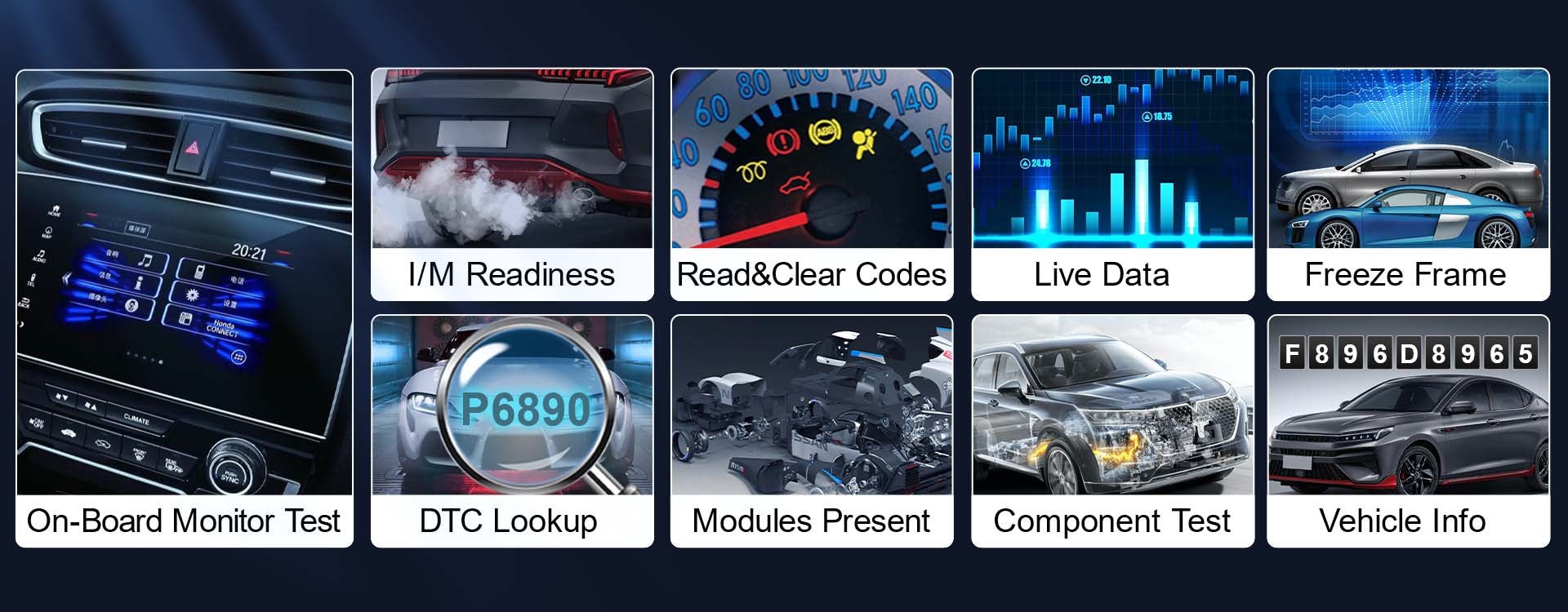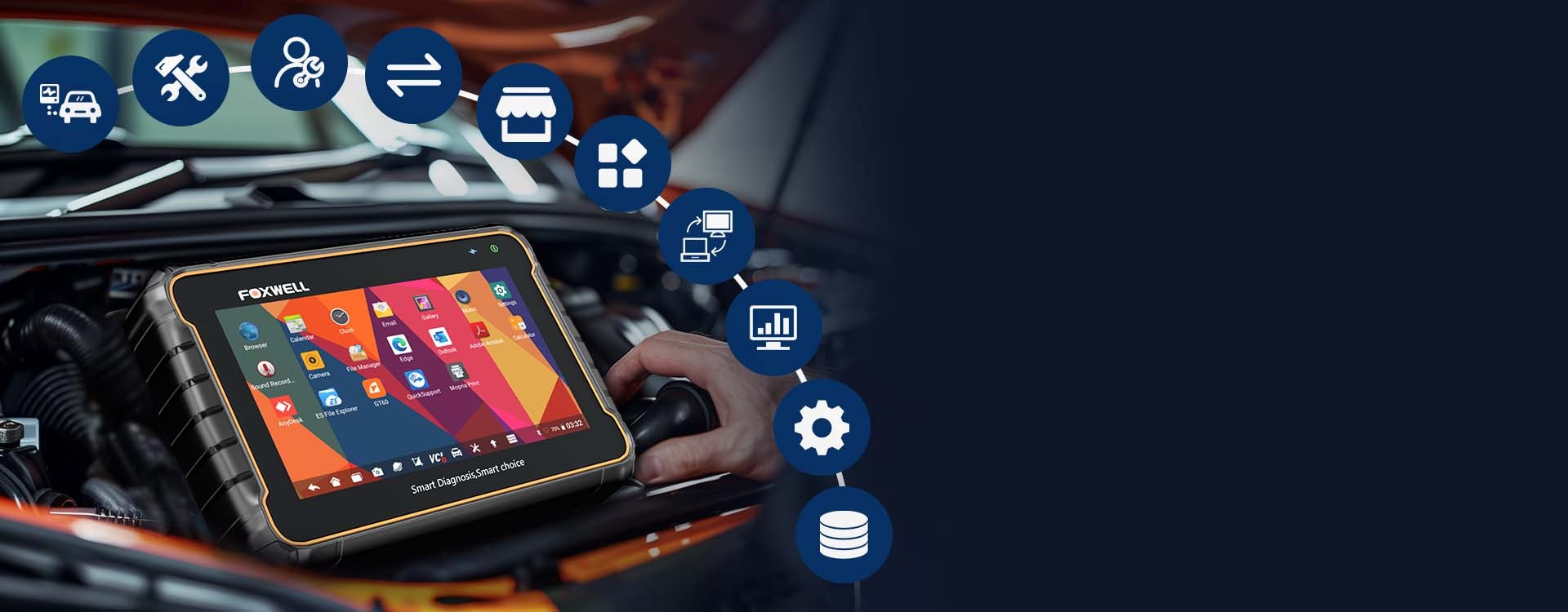When the ABS (Anti-lock Braking System) light suddenly illuminates on your dashboard, it’s more than just a minor annoyance—it’s a signal that a critical safety system in your vehicle might be compromised. Your ABS is crucial for maintaining control during hard braking, preventing wheel lock-up and skidding, especially in slippery conditions. Fortunately, an Obd2 Scanner With Abs capability can be an invaluable tool for diagnosing and potentially resolving ABS issues right in your driveway.
This guide will delve into how an OBD2 scanner equipped with ABS functionality can help you understand and address ABS warning lights. Whether you’re a seasoned DIY mechanic or a car owner looking to save on repair costs, understanding how to use an obd2 scanner with abs is essential for modern vehicle maintenance. We’ll clarify what these scanners can do, how they differ when it comes to ABS, and how to choose the right tool for the job.
Understanding OBD2 Scanners and Their Basic Functions
Think of an OBD2 scanner as a translator for your car’s onboard computer. Modern vehicles are equipped with an On-Board Diagnostics system (OBD), which monitors various systems and components. When a problem arises, the system generates diagnostic trouble codes (DTCs). An OBD2 scanner plugs into your car’s OBD2 port, typically located under the dashboard, and retrieves these codes, giving you insight into potential issues.
Here’s a breakdown of the common functions of most OBD2 scanners:
Reading and Clearing Diagnostic Trouble Codes (DTCs): At their most basic level, OBD2 scanners are designed to read and clear generic DTCs. These codes often relate to the engine and transmission and are responsible for triggering the “Check Engine” light. Common issues picked up by these codes include emission problems, engine misfires, and sensor malfunctions.
Accessing Real-Time Data: Beyond just reading codes, OBD2 scanners can display live data from your vehicle’s sensors and systems. This real-time information can include engine temperature, oxygen sensor readings, vehicle speed, and more. This live data stream is incredibly useful for diagnosing intermittent issues or monitoring system performance as you drive.
Emissions Readiness Testing: Many areas require vehicles to pass emissions tests for registration. OBD2 scanners can check your vehicle’s emissions readiness status, indicating whether your car is likely to pass or if there are unresolved issues that could cause a failure.
While these functions are incredibly useful for general car maintenance and understanding basic engine-related problems, they are often insufficient when dealing with more complex systems like the ABS.
ABS Codes vs. Generic Trouble Codes: Decoding the Difference
While all OBD2 scanners can handle basic engine and transmission codes, diagnosing ABS issues requires a scanner with specialized capabilities. It’s crucial to understand the difference between generic OBD2 codes and ABS-specific codes.
Imagine your “Check Engine” light comes on. You use a standard OBD2 scanner and retrieve a code like P0300. This is a generic OBD2 code, indicating a random engine misfire, and any basic OBD2 scanner is designed to read this standardized code.
Now, consider the scenario where your ABS light illuminates. If you use an advanced scanner, like a Foxwell NT809, which is designed to read ABS codes, you might see a code like C0035. This code is ABS-specific and points to an issue with the left front wheel speed sensor. While any OBD2 scanner can read P0300, only scanners with ABS capability can interpret C0035.
Here’s a clearer picture of why ABS codes are different:
System Focus: Standard OBD2 codes primarily focus on powertrain-related issues—the engine and transmission, the systems that make the car move. ABS codes, on the other hand, are focused on safety-critical braking components. These include wheel speed sensors, hydraulic components, and the electronic control unit that manages brake force distribution.
Specificity and Complexity: ABS codes tend to be more detailed and complex than generic codes. For example, a code like C0110 might indicate a problem within the ABS pump motor circuit, a system that is entirely separate from the engine management system and therefore invisible to a basic OBD2 scanner.
Manufacturer-Specific Variations: Unlike generic P-codes, ABS codes can have manufacturer-specific interpretations. A code like C1235 could mean different things for a Ford compared to a Toyota. This manufacturer-specific language is another reason why not all OBD2 scanners can effectively read or reset ABS codes. You need an obd2 scanner with abs compatibility to properly interface with these systems.
Understanding these key differences highlights why you need a more specialized obd2 scanner with abs functionality to diagnose and address ABS-related problems effectively.
Choosing the Right OBD2 Scanner to Reset ABS Codes
So, can OBD2 scanners reset ABS codes? Yes, absolutely, but only if you choose a scanner with the right features. When shopping for an obd2 scanner with abs reset capability, consider these key factors:
-
ABS System Compatibility: The most crucial feature is explicit ABS compatibility. Not all OBD2 scanners are created equal; basic models typically only cover engine and transmission diagnostics. You need a scanner that specifically states it can read and clear ABS codes. Look for “full system” scanners or those that list ABS as a supported system.
-
Enhanced Diagnostic Capabilities: Beyond just ABS, some scanners offer enhanced diagnostics for other safety systems like airbags (SRS) and electronic stability control (ESC). These “full-system” scanners provide broader coverage, making them a worthwhile investment if you want comprehensive diagnostic capabilities.
-
Vehicle-Specific Software and Updates: Given the manufacturer-specific nature of ABS codes, some scanners offer software updates or vehicle-specific modules to enhance compatibility with different car brands. This is particularly important if you work on a variety of vehicles or own a car from a manufacturer known for unique diagnostic protocols. Ensure the obd2 scanner with abs you choose supports your vehicle’s make and model.
Step-by-Step Guide: Using an OBD2 Scanner to Reset ABS Codes
If you’ve chosen an advanced obd2 scanner with abs capability, such as the Foxwell NT809, resetting your ABS codes is a straightforward process. Here’s a step-by-step guide:
-
Connect the Scanner: Locate the OBD2 port in your vehicle, usually found under the dashboard on the driver’s side. Plug your Foxwell NT809 or chosen scanner securely into this port.
-
Power On: Turn your vehicle’s ignition to the “ON” position, without starting the engine. This powers up the car’s systems and allows the scanner to communicate with the vehicle’s computer.
-
Vehicle Selection: Using the scanner’s interface, navigate to the vehicle selection menu. Choose your car’s make, model, and year. This ensures the scanner communicates correctly with your specific vehicle’s ABS system.
-
Access the ABS System Menu: Once your vehicle is identified, navigate through the scanner’s menus to find the “ABS System” or “Brake System” option. Select this to access the ABS diagnostic functions.
-
Read ABS Codes: Within the ABS system menu, select the option to “Read Codes” or “Trouble Codes.” The scanner will then retrieve and display any stored ABS codes. Note down these codes for reference. Common ABS codes might include C0035 (wheel speed sensor issue) or C0110 (ABS pump motor issue).
-
Address the Issue: Before clearing any codes, it’s crucial to address the underlying problem causing the ABS light. This might involve replacing a faulty wheel speed sensor, repairing wiring, or addressing other issues indicated by the codes.
-
Clear ABS Codes: After you have resolved the problem, navigate back to the ABS system menu on your scanner and select “Clear Codes” or “Erase Codes.” Confirm your selection to clear the stored ABS codes.
-
Verify and Restart: Turn off the ignition, then restart your vehicle. Check if the ABS warning light has turned off. If the light stays off, you have successfully reset the ABS system. If the light comes back on, it indicates that the underlying issue may still be present or was not fully resolved. Further diagnosis may be needed.
OBD2 Scanners vs. Professional Diagnostic Tools: Understanding the Differences
When it comes to diagnosing and resetting ABS codes, you might wonder how an obd2 scanner with abs compares to the professional-grade tools used by mechanics. Here’s a comparison table to highlight the key differences:
| Feature | Advanced OBD2 Scanners | Professional Diagnostic Tools |
|---|---|---|
| Functionality | Reset ABS, SRS, and other specialized codes; basic diagnostics | Deeper diagnostics, module coding, advanced system tests |
| Ease of Use | User-friendly, designed for DIYers | Requires training and expertise to operate effectively |
| Vehicle Compatibility | Wide range of vehicles, but check specific model support | Broadest vehicle support, including very specific systems |
| Data Accuracy | Accurate for most DIY tasks, including ABS code resets | Highly accurate, designed for complex and critical repairs |
| Price | Affordable, good value for advanced features | Expensive, typically for professional shop use |


For most DIYers and car owners, an advanced obd2 scanner with abs offers a great balance of capability and affordability. Professional tools provide more in-depth functionality but come with a higher price tag and steeper learning curve.
What to Do When ABS Codes Won’t Clear
Occasionally, you might encounter a situation where your obd2 scanner with abs is unable to clear the ABS codes. Here are a few reasons why this might happen and what you should do:
Scanner Limitations: Even with an ABS-capable scanner, there’s a chance it might not be fully compatible with your specific vehicle’s ABS system. Always double-check the scanner’s compatibility list and your vehicle’s manual.
Persistent Underlying Issue: If the ABS code immediately returns after clearing, it’s a strong indication that the underlying problem is still present. A faulty sensor, wiring issue, or hydraulic problem needs to be properly fixed before the code can be permanently cleared.
Special Reset Procedures: Some vehicles, particularly certain makes or models, may require specific or manufacturer-specific reset procedures for ABS codes. A generic obd2 scanner with abs might not support these specialized procedures.
If you are unable to clear the ABS codes with your scanner, or if the ABS light returns shortly after clearing, it’s best to consult a professional mechanic. They possess advanced diagnostic tools and expertise to pinpoint complex ABS issues and ensure your braking system is functioning correctly and safely.
Conclusion
An obd2 scanner with abs functionality is an essential tool for modern vehicle maintenance. While basic OBD2 scanners are useful for engine-related issues, they fall short when it comes to diagnosing and resolving ABS problems. Investing in an advanced scanner, like the Foxwell NT809, empowers you to read and clear ABS codes, understand potential brake system issues, and ensure your vehicle’s safety systems are functioning as intended.
Remember, addressing ABS issues promptly is crucial for your safety and the safety of others on the road. Having the right obd2 scanner with abs is the first step in taking control of your vehicle’s health and maintaining peace of mind.
FAQs
Can OBD2 clear ABS light?
Yes, an OBD2 scanner can clear the ABS light, but only if it is specifically designed with ABS compatibility. Basic OBD2 scanners that only read engine and transmission codes will not be able to clear the ABS light. You need an advanced obd2 scanner with abs capabilities for this function.
How do I clear my ABS code?
To clear an ABS code, you need to use an ABS-compatible OBD2 scanner. Connect the scanner to your vehicle’s OBD2 port, navigate to the ABS system menu on the scanner, and select the option to clear codes. Make sure you have addressed the underlying issue causing the code before clearing it.
Can you clear fault codes with OBD2?
Yes, an OBD2 scanner is designed to clear fault codes. However, the types of fault codes it can clear depend on the scanner’s capabilities. Basic scanners clear engine and transmission codes, while advanced scanners are needed to clear ABS, SRS, and other specialized system codes. For ABS codes specifically, ensure you are using an obd2 scanner with abs functionality.